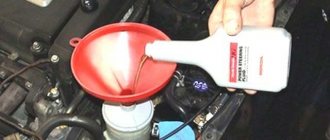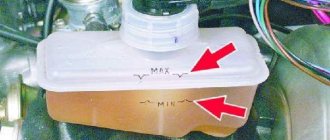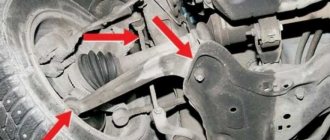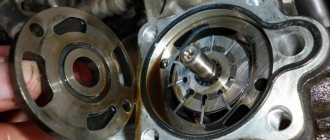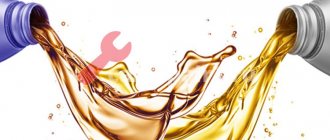What is power steering fluid
Power steering fluid is a specialized fluid that acts as a working fluid in the hydraulic power steering systems of cars, tractors and other wheeled vehicles.
Modern cars and trucks, buses, tractors and other wheeled vehicles are equipped with a system that facilitates the driver’s work - hydraulic power steering (power steering). This system consists of a liquid pump driven by the engine crankshaft, a power actuator, a control mechanism and piping. The actuator is racks or steering mechanisms with bipods, and the control mechanism is a distributor integrated with the rack or steering mechanism, which controls fluid flows depending on the direction and angle of rotation of the steering wheel.
Power steering uses various fluids as a working fluid, which are assigned several important functions:
- Transfer of force from the power steering pump to the actuator, which ensures the rotation of the steered wheels;
- Lubrication of rubbing parts of the power steering system;
- Protection of metal elements of power steering from corrosion;
- Cooling of the rubbing parts of the power steering system.
All these functions can be most effectively performed only by special fluids designed for use in power steering. These liquids have a number of features and distinctive features, which should be discussed in more detail.
Comma PSF MVCHF
Semi-synthetic hydraulic fluid for central hydraulic systems, power steering and air-hydraulic suspensions. It is often used in air conditioners, stability control systems, and roof hydraulic systems. The same color as PSF-3 and similar multi-liquids - green. Can be mixed with CHF11S, Dexron and CHF202 specifications.
Has approvals from domestic and foreign automobile concerns that use the appropriate fluids in vehicles. Experts recommend using Comma PSF in European brands of cars - both cars and trucks.
Withstands low temperatures: the manufacturer claims a temperature range of up to -54 ˚С, but car owners note that operation at -25 ˚С does not degrade its characteristics.
Classification of power steering hydraulic fluids
Fluids used in power steering can be divided according to several criteria:
- Color;
- Compound;
- Variety.
Color classification
It is wrong to be guided only by color gradation when choosing oil, although this practice is widespread among car owners. It is also often indicated what color liquids can be mixed and which ones should not be mixed.
Mixing is contraindicated with liquids based on composition and not color, and since now both mineral water and synthetics can be presented in any color, you should treat this information very carefully.
Red ATF gear oil is usually synthetic, the Dexron brand from General Motors is considered the standard, but there are products from other manufacturers, such as Revenol, Motul, Shell, Zic, etc.
Yellow oil, produced by the Daimler concern and under its license, is used in Mercedes-Benz hydraulic boosters. It can be synthetic and mineral.
Green oil. For the most part, multifunctional and universal liquids can be either synthetic or mineral in composition. They are used in power steering, suspension and other systems that operate on liquids. It cannot be mixed with other colors, except in cases where the manufacturer declares full compatibility, for example Comma PSF MVCHF is compatible with some types of Dexron.
Reds
They belong to the ATF class, that is, transmission. Most often used for automatic transmissions, but sometimes also used for power steering. The red brands Dexron II and Dexron III are developed by the automobile concern General Motors. There are other red brands, but they are manufactured under license from General Motors.
Yellow
This liquid is considered universal. This type of oil can be found in most hydraulic power steering systems. This lubricant is also used in manual and automatic transmissions.
Green
Synthetic or mineral based oil. For use exclusively in manual transmissions. You can use such a lubricant in power steering, but before doing this you need to drain all the old fluid and flush the system.
Types of power steering fluids
Power steering fluids must have different properties, which are provided by additives and chemical composition. Among them:
- required viscosity index;
- temperature resistance;
- mechanical and hydraulic properties;
- corrosion protection;
- anti-foam properties;
- lubricating properties.
All power steering fluids on the market have all these characteristics to one degree or another.
In turn, according to their chemical composition they are distinguished:
- synthetic;
- semi-synthetic;
- mineral oils.
Let's look at their differences and scope of application.
Synthetic
Synthetics are based on hydrocarbons (alkylbenzenes, polyalphaolefins) and various esters. All these compounds are obtained as a result of directed chemical synthesis from oil. This is a base to which various additives are added. Synthetic oils have the following advantages:
- high viscosity index;
- thermal-oxidative stability;
- long service life;
- low volatility;
- resistance to low and high temperatures;
- Excellent anti-corrosion, anti-foam and lubricating properties.
But even with such characteristics, fully synthetic oils are rarely used in power steering systems due to the many rubber seals that are aggressively affected by synthetics. Synthetics are used only if approved by the manufacturer. Another disadvantage of synthetics is the high price.
Semi-synthetic
To neutralize the aggressive effect on rubber parts, manufacturers add a variety of silicone additives.
Mineral
Mineral oils are based on various petroleum fractions, such as naphthenes and paraffins. 97% is a mineral base, the other 3% is additives. Such oils are more suitable for power steering, as they are neutral to rubber elements. Operating temperature ranges from -40°C to 90°C. Synthetics work up to 130°C-150°C, the lower limit is similar. Mineral oils are affordable, but in other respects they are inferior to synthetic ones. This concerns service life, foaming and lubricity.
What kind of oil should be poured into the power steering - synthetic or mineral? First of all, the one recommended by the manufacturer.
Differences between hydraulic fluids
Dexron. Lubricants have been produced since 1968. This is a separate class created by General Motors Corporation. Dexron is an official brand and is not manufactured exclusively by GM.
ATF (Automatic Transmission Fluid) - lubricants intended for automatic transmissions. Widespread among Japanese manufacturers. Often such hydraulic oil is found in power steering, most of it has a red tint.
PSF (Power Steering Fluid) – oil for hydraulic booster.
Multi HF are universal hydraulic oils for use in hydraulic power steering systems, allow complete mixing and interchangeability, and have approvals from many automakers. This oil is the best choice when purchasing.
Application
Many car manufacturers say that the power steering fluid does not need to be changed. Unfortunately, this is a mistake; replacement is necessary, since any liquid has a service life and over time its beneficial properties cease to be effective.
Before you drain the old one and fill in the new one, you need to place the car on a lift. If removal takes place in a garage, then use a jack. The front wheels must be suspended so that they do not touch the ground and can turn freely.
Having opened the hydraulic fluid expansion tank and taken a medical syringe, it is necessary to pump out the old mixture. What could not be pumped out with a syringe is drained by unscrewing the hoses from below. We turn the steering wheel left and right, this pumps the system and removes any remaining fluid. Most importantly, the engine must be turned off.
We take a canister with new hydraulic fluid Mobis NEW PSF-3 and pour it into the power steering expansion tank. The most important thing is not to overfill and top up above the minimum. To do this, there are Min and Max marks, between which the mixture should be. On some barrels there may be four such marks, but anyway, we fill in the middle.
We turn the steering wheel right and left again, now we pump into the system. The liquid level in the tank will of course drop, and you will need to top it up. This process continues until, when turning the steering wheel in different directions, it returns to normal.
We close everything and remove the jack or lower the car on a lift. We start the engine and drive a few kilometers. Open the hood and check the level; if it’s gone a little, top it up.
Changing power steering oil - description of the process
Replacing the lubricant in the power steering is a rather painstaking task; you should take the procedure seriously and follow the instructions.
Adding fluid
To add oil, it is recommended to purchase Multi HF universal fluid, since it can be mixed with absolutely any lubricant.
Instructions for adding hydraulic lubricant to the power steering:
- Inspect the power steering reservoir and mechanism for leaks. If there are any, they need to be eliminated;
- Check the hydraulic oil level in the power steering reservoir;
- After removing the plug, add fluid to about;
- Start the engine and turn the steering wheel from the extreme left to the extreme right;
- Check the lubricant level in the power steering reservoir and, if necessary, top up to about.
Complete fluid change
A complete lubricant change requires great perseverance and coordination. Hydraulic oil must be selected based on the manufacturer’s recommendations.
- Hang up the car. This is done to facilitate rotation of the steering wheel when the engine is off;
- We will need a syringe - we need to pump out all the fluid from the power steering reservoir;
- Then loosen the clamps on the hoses, remove them from the tank, rinse the container itself thoroughly;
- Direct the return line (steering rack hose) into an empty jar - the liquid remaining in the rack will drain there;
- By turning the steering wheel, remove any remaining lubricant from the mechanism. It is required to make quite intense and prolonged movements with the steering wheel;
- After the hydraulic oil stops leaking, you need to fill (rinse) the rack with freshly purchased fluid. To do this, insert a funnel into the second hose and fill it to capacity;
- After this, we repeat the manipulations with the steering wheel again. When all the oil has flowed out of the return hose, the procedure can be completed;
- Then reassemble the hydraulic power steering system in reverse order;
- Fill the mechanism reservoir with oil according to the level;
- After the system is filled, you need to turn the steering wheel from the extreme left position to the extreme right. Such manipulations should be carried out with the engine running;
- We turn off the engine, lower the car, check the tightness of the connections, and add fluid to the amplifier tank to the maximum.
This is interesting: Diagnostics of injectors - how to check it yourself: step-by-step instructions
Belt-driven power steering pump
How to top up
The process of topping up is simple - you need to unscrew the cap of the power steering expansion tank and add enough fluid so that it is between the MIN and MAX marks.
The main problem when adding power steering oil is its choice. It’s good if the replacement has not yet been made, and the system contains fluid from the manufacturer’s factory. In this case, it is enough to check the technical documentation, take the recommended oil and add to the required amount.
If you don’t know what’s in the system, we recommend replacing it right away, because in any case you’ll have to buy a canister of fluid to top it up.
I like4I don't like
Terms of use of liquids
It is also worth taking care of how to change the oil in the hydraulic booster. Such information is always contained in the car’s service book. No less often, manufacturers recommend not changing this oil at all. They are guided by a simple rule: the service life of the mixture is designed for the average life of the machine.
But a car can serve faithfully for quite a long time. If the fluid is not original, it needs to be changed more often. Some manufacturers clearly prescribe the procedure for replacing the fluid, including taking into account cases when the composition is not original. Often the control period ranges from 50 to 100 thousand kilometers.
If there is a problem with the power steering system, the first thing you need to do is change the oil. It is also worth checking the condition of the fluid in the power steering. If it has darkened, thickened, or smells unpleasant, it needs to be changed. By the way, synthetic compounds can be used much longer.
Advantages and disadvantages
Any vehicle fluid has its positive and negative qualities. Hyundai NEW PSF-3 power steering fluid has the following advantages:
- has a very gentle effect on rubber parts;
- low price;
- good kinematic viscosity;
- antioxidant properties are excellent;
- practically does not foam;
- Extends the service life of the unit, with proper operation.
Unfortunately, there are some negative characteristics, but they are few. Disadvantages of liquid:
- despite what is written in the vehicle’s operating instructions, the fluid has a short service life;
- cannot be used with other power steering fluids.
Filled power steering oil ensures high-quality operation and integrity of internal parts.
Is it possible to fill the power steering with engine oil?
Motor - definitely not, transmission - with reservations. Next we will look in detail why.
To understand whether other oils, such as motor or transmission oils, can be poured into the power steering, you need to know what functions it performs.
The power steering fluid must cope with the following tasks:
- Lubrication of all power steering components;
- Protection against corrosion and wear of parts;
- Pressure transfer;
- Prevents foaming;
- System cooling.
The above characteristics are achieved by adding various additives, the presence and combination of which gives power steering oil the necessary qualities.
As you understand, the tasks of motor oil are somewhat different, so it is highly not recommended to pour it into the power steering.
Regarding transmission oil, everything is not so clear; the Japanese often use the same ATF fluid for automatic transmission and power steering. Europeans insist on using special PSF (Power Steering Fluid) oils.
Castrol Dexron VI
Red transmission fluid designed for automatic transmissions. It is used mainly in modern automatic transmission models with the maximum level of fuel economy, and is characterized by low viscosity. Country of origin: Germany. Manufactured from high-quality base oils with the addition of special additives. Meets the requirements of such automakers as GM and Ford, and is approved by the Japanese standard JASO 1A.
Castrol Dexron VI is often recommended by experts as a worthy and high-quality replacement for the original ATF Dexron for Korean or Japanese cars.

